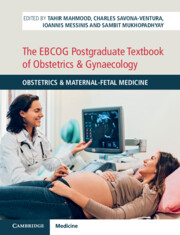Book contents
- The EBCOG Postgraduate Textbook of Obstetrics & Gynaecology
- The EBCOG Postgraduate Textbook of Obstetrics & Gynaecology
- Copyright page
- Dedication
- Contents
- Contributors
- Preface
- Section 1 Basic Sciences in Obstetrics
- Section 2 Early Pregnancy Problems
- Section 3 Fetal Medicine
- Chapter 10 Pre-Conception Care
- Chapter 11 Ultrasound Scanning in the First Trimester of Pregnancy
- Chapter 12 Prenatal Diagnostic Techniques
- Chapter 13 Invasive Fetal Therapies
- Chapter 14 Normal Fetal Growth and Fetal Macrosomia
- Chapter 15 Fetal Haemolysis
- Chapter 16 Antenatal Care of a Normal Pregnancy
- Chapter 17 Screening for High-Risk Pregnancy
- Chapter 18 Multiple Pregnancy
- Chapter 19 Intrauterine Growth Restriction
- Chapter 20 Fetal Origin of Adult Disease
- Chapter 21 Antepartum Haemorrhage
- Chapter 22 Obstetric Care of Migrant Populations
- Chapter 23 Care of Women with Previous Adverse Pregnancy Outcome
- Chapter 24 Preterm Prelabour Rupture of Membranes
- Section 4 Maternal Medicine
- Section 5 Intrapartum Care
- Section 6 Neonatal Problems
- Section 7 Placenta
- Section 8 Public Health Issues in Obstetrics
- Section 9 Co-Morbidities during Pregnancy
- Index
- Plate Section (PDF Only)
- References
Chapter 12 - Prenatal Diagnostic Techniques
from Section 3 - Fetal Medicine
Published online by Cambridge University Press: 20 November 2021
- The EBCOG Postgraduate Textbook of Obstetrics & Gynaecology
- The EBCOG Postgraduate Textbook of Obstetrics & Gynaecology
- Copyright page
- Dedication
- Contents
- Contributors
- Preface
- Section 1 Basic Sciences in Obstetrics
- Section 2 Early Pregnancy Problems
- Section 3 Fetal Medicine
- Chapter 10 Pre-Conception Care
- Chapter 11 Ultrasound Scanning in the First Trimester of Pregnancy
- Chapter 12 Prenatal Diagnostic Techniques
- Chapter 13 Invasive Fetal Therapies
- Chapter 14 Normal Fetal Growth and Fetal Macrosomia
- Chapter 15 Fetal Haemolysis
- Chapter 16 Antenatal Care of a Normal Pregnancy
- Chapter 17 Screening for High-Risk Pregnancy
- Chapter 18 Multiple Pregnancy
- Chapter 19 Intrauterine Growth Restriction
- Chapter 20 Fetal Origin of Adult Disease
- Chapter 21 Antepartum Haemorrhage
- Chapter 22 Obstetric Care of Migrant Populations
- Chapter 23 Care of Women with Previous Adverse Pregnancy Outcome
- Chapter 24 Preterm Prelabour Rupture of Membranes
- Section 4 Maternal Medicine
- Section 5 Intrapartum Care
- Section 6 Neonatal Problems
- Section 7 Placenta
- Section 8 Public Health Issues in Obstetrics
- Section 9 Co-Morbidities during Pregnancy
- Index
- Plate Section (PDF Only)
- References
Summary
Prenatal diagnosis provides the pregnant woman and her partner with information on possible fetal chromosomal aberrations and heritable genetic diseases. Genetic counselling should be provided to the couple with information on the technical procedure, predictive values, risk estimates, expected and unexpected results and management options. Prenatal diagnosis is typically performed early in pregnancy to give the couple the possibility to consider termination of pregnancy. The policy on prenatal diagnosis varies throughout Europe depending on tradition and national legislation, resulting in inconsistent use of the different screening and invasive methods.
- Type
- Chapter
- Information
- The EBCOG Postgraduate Textbook of Obstetrics & GynaecologyObstetrics & Maternal-Fetal Medicine, pp. 102 - 108Publisher: Cambridge University PressPrint publication year: 2021

